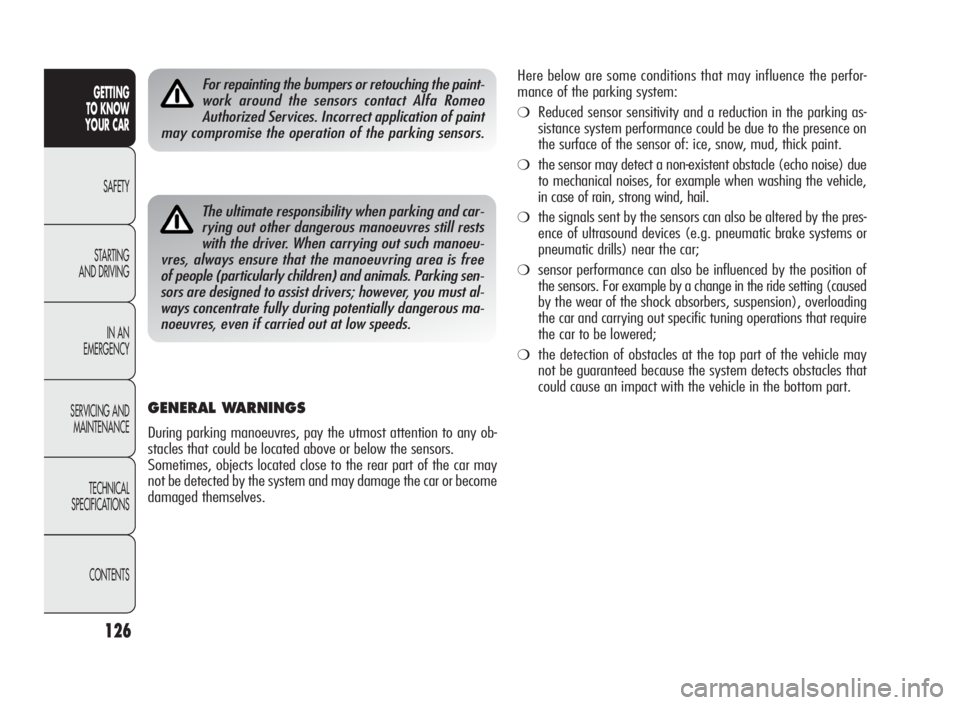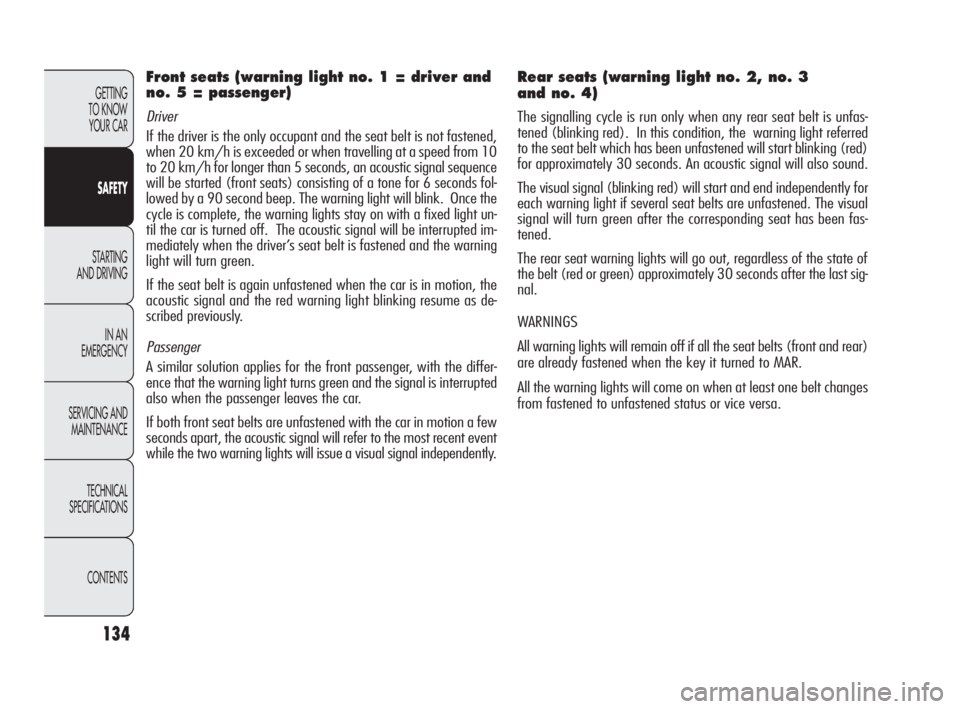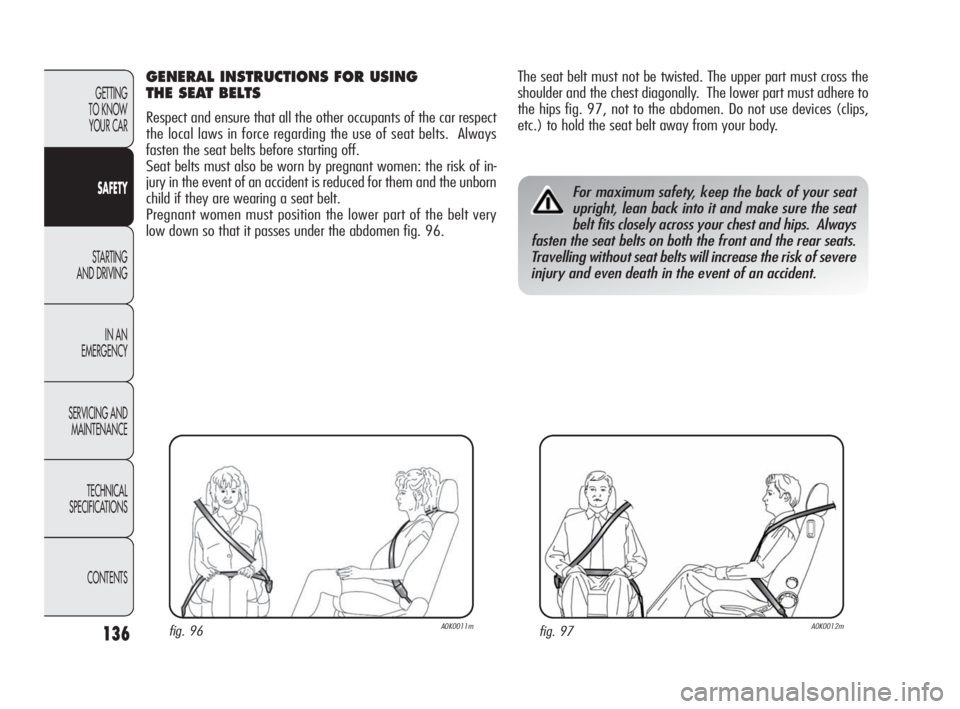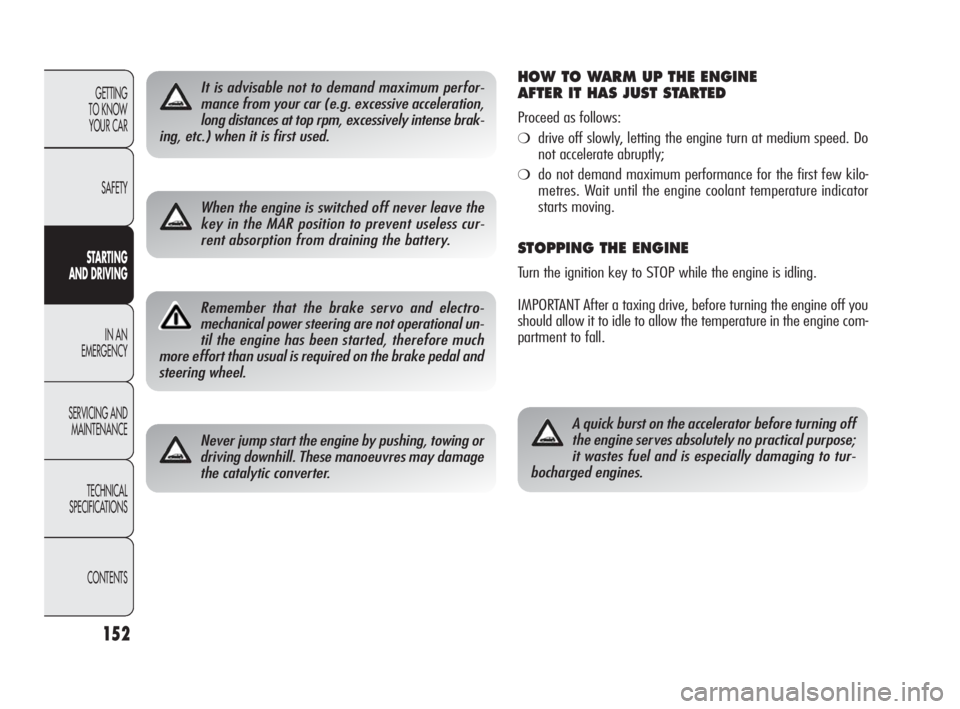ESP Alfa Romeo Giulietta 2010 Owner handbook (in English)
[x] Cancel search | Manufacturer: ALFA ROMEO, Model Year: 2010, Model line: Giulietta, Model: Alfa Romeo Giulietta 2010Pages: 294, PDF Size: 5.25 MB
Page 113 of 294

112
GETTING
TO KNOW
YOUR CAR
SAFETY
STARTING
AND DRIVING
IN AN
EMERGENCY
SERVICING AND
MAINTENANCE
TECHNICAL
SPECIFICATIONS
CONTENTS
“ELECTRONIC Q2” SYSTEM (“E-Q2”)
The “Electronic Q2” system uses the braking system to create an
effect similar to a limited slip differential.
The front braking circuit, when accelerating around a corner, acts
on the inside wheel to increase the drive to the outside wheel (in-
creased load), dynamically and continuously distributing the torque
between the front drive wheels according to driving and road con-
ditions.
The system, combined with Mc Pherson front suspension, allows
particularly effective, sporty driving.
DST SYSTEM (Dynamic Steering Torque)
This function integrates Dual Pinion active steering into the opera-
tion of VDC. For particular manoeuvres, VDC controls the steering
to actuate a steering torque and assist the driver in the best pos-
sible way. The system operates the brakes and steering in a coor-
dinated manner to increase the suspension and safety level of the
car as a whole. The steering provides addition torque on the steer-
ing wheel.
RAB SYSTEM (Ready Alert Brake)
(“Dynamic” mode only)
By pre-approaching the brake pads (front and rear) after rapid ac-
celerator release, this function provides prompter braking and re-
duces stopping distance.
BRAKE ASSIST
(emergency braking assistance)
The system, which cannot be turned off, recognises emergency
braking (on the basis of the brake pedal operating speed) and
speeding up the response of the braking system. The Brake
Assist function is deactivated in the event of VDC system fault.
MSR SYSTEM
(Motor Schleppmoment Regelung)
This system is an integral part of the ABS, that intervenes, if there
is a sudden change to a lower gear, restoring torque to the engine,
thereby preventing excessive drive at the drive wheels which, es-
pecially in poor grip conditions, could lead to a loss in stability.
CBC SYSTEM (Cornering Braking Control)
This system improves the distribution of the braking pressure at the
four wheels (to fully exploit the grip available on the ground) when
braking round bends when the ABS intervenes. This improves stop-
ping distances and above all vehicle stability when cornering.
001-130 Alfa Giulietta EN 5ed 26-07-2010 16:34 Pagina 112
Page 114 of 294

113
GETTING
TO KNOW
YOUR CAR
SAFETY
STARTING
AND DRIVING
IN AN
EMERGENCY
SERVICING AND
MAINTENANCE
TECHNICAL
SPECIFICATIONS
CONTENTS
“Alfa DNA” SYSTEM
(Dynamic control system)
This device allows, using switch A-fig. 80 (on the central tunnel),
three response modes to be selected according to driving style
and road conditions:
❍d = Dynamic (for sporty driving)
❍n = Normal (normal driving mode)
❍a = All Weather (driving mode for poor grip conditions, i.e. rain
and snow on the road)
The device also acts on the dynamic vehicle control systems (en-
gine, steering, VDC system, instrument panel).
fig. 80A0K0072m
DRIVING MODES
Switch A-fig. 80 is a monostable switch, i.e. it always remains in the
central position. The selected driving mode is indicated by the corre-
sponding LED coming on in the panel and by an indication on the re-
configurable multifunction display, as illustrated below:
A0K0009m
A0K0010m
Dynamic mode(display image available for
versions/markets where
provided)All Weather mode
“Normal” mode
When “Normal” mode is selected, no messages or symbols are
shown on the display.
VDCandASR: operating thresholds set for normal comfort lev-
el for normal driving conditions.
Steering tuning: functions aimed at providing comfort in nor-
mal conditions of use.
DST: Standard braking control coordinated with ABS/VDC.
Standard control over lateral acceleration.
Oversteer compensation: a slight pulse on the steering wheel
encourages the driver to carry out the most appropriate ma-
noeuvre.
Engine: Standard responsiveness
001-130 Alfa Giulietta EN 5ed 26-07-2010 16:34 Pagina 113
Page 115 of 294

114
GETTING
TO KNOW
YOUR CAR
SAFETY
STARTING
AND DRIVING
IN AN
EMERGENCY
SERVICING AND
MAINTENANCE
TECHNICAL
SPECIFICATIONS
CONTENTS
TURNING “Dynamic” MODE ON/OFF
On
Move lever A-fig. 80 upwards (to the letter “d”) and hold in this
position for 0.5 seconds until the corresponding LED lights up or
the word “Dynamic” appears on the display (see figures). The
switch A will go back to central position after having been released.Electronic Q2: improves traction and reduces understeer in acce-
leration while exiting curves.
RAB: pre-positioning of the brake pads (front and rear) following
a rapid release of the accelerator pedal to reduce braking
times, shorten stopping distances and improve the feel of
the brake pedal.
The activation of the Dynamic mode is also shown by the change
in the instrument panel lighting that, after decreasing, reaches
the highest luminosity and then returns to the previously set va-
lues.
Off
To turn “Dynamic” mode off and go back to “Normal” mode, move
the lever as described above once again. In this case, the LED cor-
responding to “Normal” mode will light up and the words “Nor-
mal on” will appear on the reconfigurable multifunction display
(see figure).
A0K1225gA0K1055g
A0K1052g
VDCandASR: intervention thresholds that allow more enjoy-
able, sportier driving whilst guaranteeing stabil-
ity in the event of loss of control. Improves trac-
tion whilst accelerating on bends.
Steering tuning: sports mode operation.
DST:Standard brake control coordinated with ABS/VDC.
Standard control over lateral acceleration
Oversteer compensation adapted to VDC/ASR intervention
thresholds: a slight pulse on the steering wheel encourage
the driver to carry the most appropriate manoeuvre.
Engine: Prompter response + Overboost to maximise torque (for
versions/markets, where provided).
001-130 Alfa Giulietta EN 5ed 26-07-2010 16:34 Pagina 114
Page 116 of 294

115
GETTING
TO KNOW
YOUR CAR
SAFETY
STARTING
AND DRIVING
IN AN
EMERGENCY
SERVICING AND
MAINTENANCE
TECHNICAL
SPECIFICATIONS
CONTENTS
TURNING “All Weather” MODE ON/OFF
On
Move switch A-fig. 80 downwards (to the letter “a”) and hold in
this position for 0.5 seconds until the corresponding LED lights up
or the word “All Weather” appears on the display (see figures).
A0K1226gA0K1180g
VDCandASR: intervention thresholds to ensure maximum safe-
ty and control even in critical conditions (e.g. rain,
snow, etc.).
Steering tuning: sports mode operation.
DST: Higher brake control coordinated with ABS/VDC.
Standard control over lateral acceleration
Oversteer compensation adapted to VDC/ASR intervention
thresholds: a slight pulse on the steering wheel encour-
ages the driver to carry the most appropriate manoeuvre.
Engine: Standard response
On
To disengage “All Weather” mode and return to “Normal”, carry
out the same procedure described for“Dynamic” mode, however
moving lever A-fig. 80 to “a”.
IMPORTANT
❍It is not possible to go directly from “Dynamic” mode to “All
Weather” mode and vice versa. You must always first go back
to “Normal” mode and then select the other mode.
❍“Dynamic” mode was engaged when the engine was switched
off, the next time it is started “Normal” mode is automatical-
ly selected. If, however, “All Weather” or “Normal”, was en-
gaged when the engine was switched off, the selected mode
is maintained the next time it is started.
❍“Dynamic” mode cannot be engaged at speeds of above 110
km/h.
❍In the event of system failure or a fault with lever A-fig. 80,
no driving modes can be selected. The display will show a warn-
ing message.
001-130 Alfa Giulietta EN 5ed 26-07-2010 16:34 Pagina 115
Page 127 of 294

126
GETTING
TO KNOW
YOUR CAR
SAFETY
STARTING
AND DRIVING
IN AN
EMERGENCY
SERVICING AND
MAINTENANCE
TECHNICAL
SPECIFICATIONS
CONTENTS
GENERAL WARNINGS
During parking manoeuvres, pay the utmost attention to any ob-
stacles that could be located above or below the sensors.
Sometimes, objects located close to the rear part of the car may
not be detected by the system and may damage the car or become
damaged themselves.
The ultimate responsibility when parking and car-
rying out other dangerous manoeuvres still rests
with the driver. When carrying out such manoeu-
vres, always ensure that the manoeuvring area is free
of people (particularly children) and animals. Parking sen-
sors are designed to assist drivers; however, you must al-
ways concentrate fully during potentially dangerous ma-
noeuvres, even if carried out at low speeds.
Here below are some conditions that may influence the perfor-
mance of the parking system:
❍Reduced sensor sensitivity and a reduction in the parking as-
sistance system performance could be due to the presence on
the surface of the sensor of: ice, snow, mud, thick paint.
❍the sensor may detect a non-existent obstacle (echo noise) due
to mechanical noises, for example when washing the vehicle,
in case of rain, strong wind, hail.
❍the signals sent by the sensors can also be altered by the pres-
ence of ultrasound devices (e.g. pneumatic brake systems or
pneumatic drills) near the car;
❍sensor performance can also be influenced by the position of
the sensors. For example by a change in the ride setting (caused
by the wear of the shock absorbers, suspension), overloading
the car and carrying out specific tuning operations that require
thecartobelowered;
❍the detection of obstacles at the top part of the vehicle may
not be guaranteed because the system detects obstacles that
could cause an impact with the vehicle in the bottom part.
For repainting the bumpers or retouching the paint-
work around the sensors contact Alfa Romeo
Authorized Services. Incorrect application of paint
may compromise the operation of the parking sensors.
001-130 Alfa Giulietta EN 5ed 26-07-2010 16:34 Pagina 126
Page 135 of 294

134
GETTING
TO KNOW
YOUR CAR
SAFETY
STARTING
AND DRIVING
IN AN
EMERGENCY
SERVICING AND
MAINTENANCE
TECHNICAL
SPECIFICATIONS
CONTENTS
Front seats (warning light no. 1 = driver and
no. 5 = passenger)
Driver
If the driver is the only occupant and the seat belt is not fastened,
when 20 km/h is exceeded or when travelling at a speed from 10
to 20 km/h for longer than 5 seconds, an acoustic signal sequence
will be started (front seats) consisting of a tone for 6 seconds fol-
lowed by a 90 second beep. The warning light will blink. Once the
cycle is complete, the warning lights stay on with a fixed light un-
til the car is turned off. The acoustic signal will be interrupted im-
mediately when the driver’s seat belt is fastened and the warning
light will turn green.
If the seat belt is again unfastened when the car is in motion, the
acoustic signal and the red warning light blinking resume as de-
scribed previously.
Passenger
A similar solution applies for the front passenger, with the differ-
ence that the warning light turns green and the signal is interrupted
also when the passenger leaves the car.
If both front seat belts are unfastened with the car in motion a few
seconds apart, the acoustic signal will refer to the most recent event
while the two warning lights will issue a visual signal independently.
Rear seats (warning light no. 2, no. 3
and no. 4)
The signalling cycle is run only when any rear seat belt is unfas-
tened (blinking red). In this condition, the warning light referred
to the seat belt which has been unfastened will start blinking (red)
for approximately 30 seconds. An acoustic signal will also sound.
The visual signal (blinking red) will start and end independently for
each warning light if several seat belts are unfastened. The visual
signal will turn green after the corresponding seat has been fas-
tened.
The rear seat warning lights will go out, regardless of the state of
the belt (red or green) approximately 30 seconds after the last sig-
nal.
WARNINGS
All warning lights will remain off if all the seat belts (front and rear)
are already fastened when the key it turned to MAR.
All the warning lights will come on when at least one belt changes
from fastened to unfastened status or vice versa.
131-150 Alfa Giulietta EN 4ed 27-04-2010 11:15 Pagina 134
Page 137 of 294

136
GETTING
TO KNOW
YOUR CAR
SAFETY
STARTING
AND DRIVING
IN AN
EMERGENCY
SERVICING AND
MAINTENANCE
TECHNICAL
SPECIFICATIONS
CONTENTS
The seat belt must not be twisted. The upper part must cross the
shoulder and the chest diagonally. The lower part must adhere to
the hips fig. 97, not to the abdomen. Do not use devices (clips,
etc.) to hold the seat belt away from your body.
fig. 97A0K0012m
For maximum safety, keep the back of your seat
upright, lean back into it and make sure the seat
belt fits closely across your chest and hips. Always
fasten the seat belts on both the front and the rear seats.
Travelling without seat belts will increase the risk of severe
injury and even death in the event of an accident.
GENERAL INSTRUCTIONS FOR USING
THE SEAT BELTS
Respect and ensure that all the other occupants of the car respect
the local laws in force regarding the use of seat belts. Always
fasten the seat belts before starting off.
Seat belts must also be worn by pregnant women: the risk of in-
jury in the event of an accident is reduced for them and the unborn
child if they are wearing a seat belt.
Pregnant women must position the lower part of the belt very
low down so that it passes under the abdomen fig. 96.
fig. 96A0K0011m
131-150 Alfa Giulietta EN 4ed 27-04-2010 11:15 Pagina 136
Page 141 of 294

140
GETTING
TO KNOW
YOUR CAR
SAFETY
STARTING
AND DRIVING
IN AN
EMERGENCY
SERVICING AND
MAINTENANCE
TECHNICAL
SPECIFICATIONS
CONTENTS
GROUP 2 fig. 101
Children from 15 to 25 kg can be secured using the car seat belts
directly. The child seat is needed only to position the child correctly
with respect to the belts so that the diagonal section crosses the
child’s chest and never the neck, and the lower part is snug on
the hips not the abdomen.
GROUP 3 fig. 102
For children between 22 kg and 36 kg, there are boosters allow-
ing the seat belt to fit correctly.
Fig. 102 shows proper child seat positioning on the rear seat.
fig. 101A0K0016mfig. 102A0K0017m
The diagrams are indicative and provided for as-
sembly purposes only. For assembly, refer to the
instructions supplied with the child seat.
131-150 Alfa Giulietta EN 4ed 27-04-2010 11:15 Pagina 140
Page 153 of 294

152
GETTING
TO KNOW
YOUR CAR
SAFETY
STARTING
AND DRIVING
IN AN
EMERGENCY
SERVICING AND
MAINTENANCE
TECHNICAL
SPECIFICATIONS
CONTENTS
It is advisable not to demand maximum perfor-
mance from your car (e.g. excessive acceleration,
long distances at top rpm, excessively intense brak-
ing, etc.) when it is first used.
Remember that the brake servo and electro-
mechanical power steering are not operational un-
til the engine has been started, therefore much
more effort than usual is required on the brake pedal and
steering wheel.
Never jump start the engine by pushing, towing or
driving downhill. These manoeuvres may damage
the catalytic converter.
When the engine is switched off never leave the
key in the MAR position to prevent useless cur-
rent absorption from draining the battery.
HOW TO WARM UP THE ENGINE
AFTER IT HAS JUST STARTED
Proceed as follows:
❍drive off slowly, letting the engine turn at medium speed. Do
not accelerate abruptly;
❍do not demand maximum performance for the first few kilo-
metres. Wait until the engine coolant temperature indicator
starts moving.
STOPPING THE ENGINE
Turn the ignition key to STOP while the engine is idling.
IMPORTANT After a taxing drive, before turning the engine off you
should allow it to idle to allow the temperature in the engine com-
partment to fall.
A quick burst on the accelerator before turning off
the engine serves absolutely no practical purpose;
it wastes fuel and is especially damaging to tur-
bocharged engines.
151-160 Alfa Giulietta EN 3ed 13-04-2010 11:46 Pagina 152
Page 158 of 294

157
GETTING
TO KNOW
YOUR CAR
SAFETY
STARTING
AND DRIVING
IN AN
EMERGENCY
SERVICING AND
MAINTENANCE
TECHNICAL
SPECIFICATIONS
CONTENTS
TOWING TRAILERS
IMPORTANT
The car must be provided with a type-approved tow hook and ad-
equate electric system to tow caravans or trailers. Installation must
be carried out by a specialist.
Install any specific and/or additional rear-view mirrors in accor-
dance with the highway code of the country in which you are trav-
elling.
Remember that when towing a trailer, steep hills are harder to climb,
braking distances increase and overtaking takes longer depending
on the overall weight.
Engage a low gear when driving downhill, rather than constantly
using the brake.
The weight of the trailer reduces the load capacity of the car by the
same amount. Consi
der the weight at full load, including acces-
sories and luggage, to make sure you do not exceed the maximum
towable weight (shown in the registration document).
Respect the speed limits specific to each country for vehicles tow-
ing trailers. In any event do not exceed 100 km/h.
INSTALLING A TOW HOOK
Contact Alfa Romeo Authorized Services to install a tow hook.
The ABS with which the car is equipped will not con-
trol the braking system of the trailer. Take extra
care when travelling on slippery roads.
Never modify the braking system of the car to con-
trol the trailer brake. The trailer braking system
must be fully independent from the hydraulic sys-
tem of the car.
151-160 Alfa Giulietta EN 3ed 13-04-2010 11:46 Pagina 157